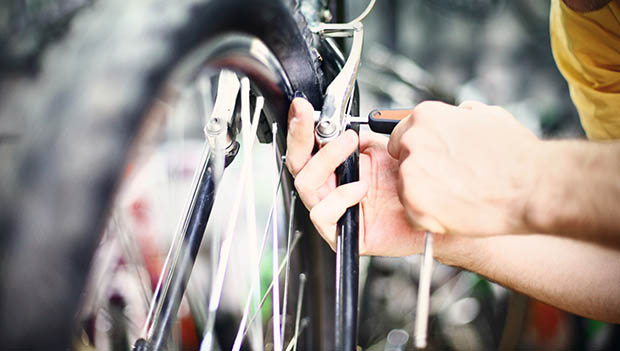
Just like pumping up your tires and lubing your chain, it's critical to check your brakes before you swing your leg over your saddle. It goes without saying, but we're going to anyway: Your brakes are the only thing separating you from a whole range of speed-related accidents.
Squeezing the brake lever is a reaction all cyclists learn right away, but maintaining your brakes is another issue altogether. Many of us have the bad habit of riding until something fails, and while that generally means a misaligned derailleur or excess chain stretch, it's a worst-case scenario when our brakes fail.
So how can you tell when you need to replace your brake pads? Rim brakes and disc brakes have different criteria, but it's important to monitor wear on a monthly basis to not only prevent damage to your rotors or rims but guarantee maximum stopping power as well.
Here's what to keep in mind.
Rim Brakes
With most Tour de France teams opting for bikes equipped with disc brakes, it seems rim brakes are going the way of newspapers and compact discs. Despite this switch, the majority of bikes on the road today still feature rim brakes, and monitoring your brake pads couldn't be easier.
Most rim brake pads have some sort of "tread" that can be used to determine wear. Simply monitor the depth of this tread, and once it's shallow (or nonexistent), it's time to replace. Also, if you notice uneven wear, adjust where the pad makes contact with the rim or re-center the caliper so it applies even pressure on both sides.
Disc Brakes
Disc brakes have many advantages over rim brakes, including better performance in inclement weather and the ability to feather the brakes more precisely. Disc brakes aren't without their flaws though--they're generally heavier and the pads wear out faster than rim brake pads (and can make some pretty terrible noises if not aligned properly).
Disc brake pad thicknesses can vary, but generally they're about 4mm thick when new. Notice when your brakes are new, there's less play in the brake lever. Over time these pads will wear out, and at this point you'll notice you'll have to squeeze the lever a bit more to get the same stopping power. Replace when there's just over 1mm left--if you let it go too far, you run the risk of the metal behind the pad rubbing directly on the metal disc.
Things to Keep in Mind
Both rim and disc brakes wear at different rates depending on the conditions and task at hand. As mentioned above, always check your brake pads at least once a month to see if they need to be replaced.
Weather can change how often you should check (and replace) your pads. For example, if you live in an area with wet conditions, it's common for dirt and grime to stick to your rims and discs, which wear through your pads faster. If this is the case, be sure to remove any debris from your pads/surfaces once you return home from every ride or before you head out for your next ride. Alcohol is a great way to clean dirty rims.
Elevation gain is another thing to keep in mind. This will sound straightforward, but if you do the majority of your training on flat ground, your brake pads will last longer than for someone who trains in a hilly area. The amount of friction required to stop a descending cyclist is far greater.
In a similar vein, a rider's weight and braking style makes a big difference on how fast their brake pads wear out. The more you weigh, the more stopping power is needed to slow you down. Brake pads also wear out faster when stopping quickly over a shorter distance instead of allowing a more gradual stop over a farther distance.
Lastly, if you're on the fence about whether or not your brakes need to be replaced, it's always better to err on the side of caution. You don't want to be out on a long ride and not have your brakes work as they should--this can not only be a costly mistake money-wise but potentially dangerous as well.
READ THIS NEXT: How to Tell When You Need to Replace Your Road Bike Tires








Discuss This Article